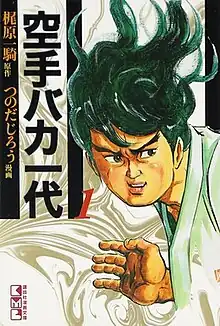| Karate Master | |
 Volume one cover art | |
| 空手バカ一代 (Karate Baka Ichidai) | |
|---|---|
| Genre | |
| Manga | |
| Written by | Ikki Kajiwara |
| Illustrated by | Jirō Tsunoda (1971-1973) Jōya Kagemaru |
| Published by | Kodansha |
| Magazine | Weekly Shōnen Magazine |
| Demographic | Shōnen |
| Original run | 1971 – 1977 |
| Volumes | 29 |
| Anime television series | |
| Directed by | Osamu Dezaki |
| Produced by | Eisuke Nozawa Nobuo Inada |
| Studio | TMS Entertainment |
| Licensed by | |
| Original network | NET |
| Original run | October 3, 1973 – September 25, 1974 |
| Episodes | 47 |
| Live-action film | |
| Directed by | Kazuhiko Yamaguchi |
| Studio | Toei |
| Released | 14 May 1977 |
| Runtime | 91 minutes |
Karate Master (空手バカ一代, Karate Baka Ichidai, lit. "A Karate-Crazy Life") is a Japanese manga drawn by Jirō Tsunoda and Jōya Kagemaru, with the story written by Ikki Kajiwara. The story was inspired by the life of the real-life karate martial artist Mas Oyama.[1][2]
The manga was published in Weekly Shōnen Magazine between 1971 and 1977, and accumulated in 29 tankōbon volumes.[1] It was adapted into an anime television series from 1973 to 1974, and a live-action film in 1977.
Anime and film adaptations
The anime television series was produced by Tokyo Movie and aired Wednesdays, from 19:30 to 20:00, on NET from October 3, 1973 to September 25, 1974, totaling 47 episodes.[1][3][4]
The manga was first adapted into a live-action film by Toei as Karate Baka Ichidai, which was released on 14 May 1977 (the English release title was Karate for Life).[5] It was directed by Kazuhiko Yamaguchi and starred Shin'ichi ("Sonny") Chiba.[5] The two-part film, Shin Karate Baka Ichidai: Kakutōsha, which was directed by Takeshi Miyasaka and released in 2003 and 2004 to commemorate the seventeenth anniversary of Kajiwara's death, is often treated as an adaptation of the manga,[5] but its direct source is a book by Hisao Maki, Kajiwara's younger brother.[6]
The anime is now available on Hulu (in the U.S.) under the name Karate Master. Discotek Media has licensed the anime for home video release in North America.[7]
Reception and legacy
The success of the manga and the anime are often credited for producing a "karate boom" in Japan in the early 1970s.[8][9]
Video game artist Keiji Inafune drew inspiration from Karate Master for several character designs in the arcade fighting game Street Fighter (1987).[10]
References
- 1 2 3 "Karate baka ichidai". Dejitaru Daijisen Purasu (in Japanese). Shogakukan. Retrieved 11 May 2014.
- ↑ "Waru Action Manga Artist Joya Kagemaru Passes Away". Anime News Network. Retrieved 2014-03-23.
- ↑ "Karate baka ichidai". Movie Square (in Japanese). Retrieved 11 May 2014.
- ↑ "TV Anime Karate baka ichidai". AllCinema (in Japanese). Retrieved 11 May 2014.
- 1 2 3 "Karate baka ichidai". Kinenote (in Japanese). Kinema Junpo. Retrieved 11 May 2014.
- ↑ "Shin Karate Baka Ichidai: Kakutōsha". Cinema Topics Online (in Japanese). Retrieved 11 May 2014.
- ↑ "Discotek Adds Hana Yori Dango, 07-Ghost, Beelzebub, Kyousougiga, Getter Robo Armageddon, Z/X Iginition, Karate Master". Anime News Network. August 27, 2015. Retrieved August 29, 2015.
- ↑ Hashimoto, Norihiro. "'Karate Saikyō Gensō' Futatabi". Number (in Japanese). Bungei Shunju. Retrieved 11 May 2014.
- ↑ "1969-1987". Kokushin Kaikan no Rekishi (in Japanese). Kokushin Kaikan. Retrieved 11 May 2014.
- ↑ McLaughlin, Rus (16 February 2009). "IGN Presents the History of Street Fighter". IGN. Retrieved 31 January 2022.
External links
- Karate Master on TMS Entertainment's website
- Karate Baka Ichidai on TMS Entertainment's website (in Japanese)
- Karate Master at IMDb
- Karate Master (manga) at Anime News Network's encyclopedia